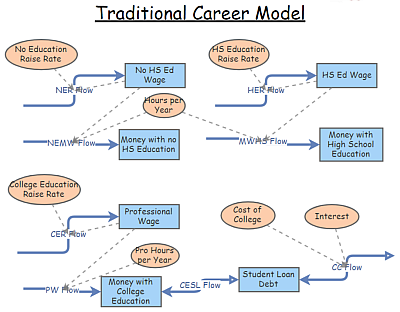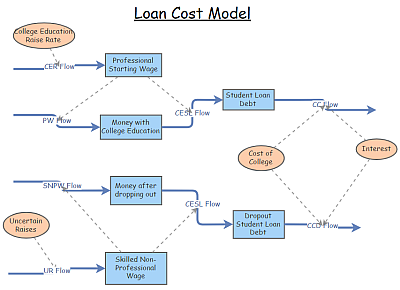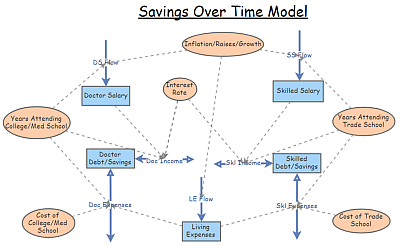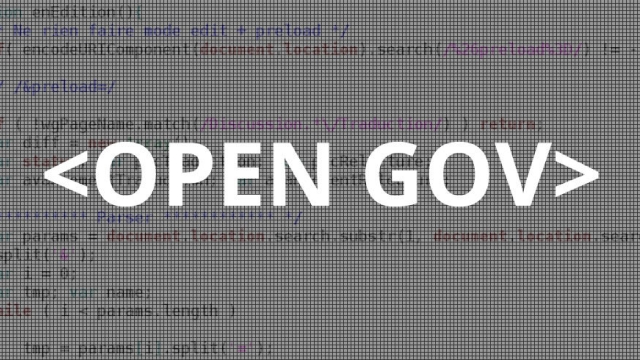
Applied Understanding: To Degree or Not [Systems thinking & modelling series]
This is part 27 of a series of articles featuring the book Beyond Connecting the Dots, Modeling for Meaningful Results.
Decision making around one’s career may be a lot like chutes and ladders; well made early decisions produce great results later. Racing to the top of a career to find out it is NOT your passion may indeed land you on a chute that takes you way back.
My friend and fellow scout leader Andy became a dentist because his dad, brother, and uncle all were dentists. After 7 years of school, more than $100,000 of debt and no savings, and three years of hating to get up in the morning to go to work – he finally admitted to himself and family that he hates looking in peoples’ mouths! Andy started a new career as a computer programmer not all the way at the bottom, but close – 10 years behind where he might have been with a more deliberate exploration of career options and costs.
While choosing one’s career has always been a mix of exploration, finding one’s passion, mentoring, formal and informal education, our world and labor economy has changed dramatically in the past 40 years. Our schools and employers, especially public employers like utilities, are just catching up. Moreover, our k-12 system may have been designed for a different age and time when jobs were plentiful and employers had formal training programs. College grads used to spend 3-5 years in a job and a department before moving to another and another over a 20-30 year career.
In those days, the classical discussion on the merits and ROI of going to college centered around the employers’ well documented data that hiring high school and college educated employees led to lower job training costs. A more literate and capable workforce permitted the corporation to save training dollars and produce revenue faster.1
There is no longer a world full of blue chip employers looking for high school and college grads to fill entry level jobs, complete with corporate training plans. Unemployment at all time highs also has great social costs in crime, foreclosures, poverty, and health.
Many college grads today find themselves up to their ears in debt and living in the basement working minimum wage jobs in retail and fast food. Some economists believe that student loan debt and the SALLYMAE bubble are the next shoes to drop. College grad starting salaries are at all time lows, while student loans are at all time highs. Employees change jobs every 2-3 years (often a victim of economic downturns) and hold seven careers in a 30-40 year work life. As retirement becomes out of reach for many, older employees are working longer if they can for all sorts of reasons, competing for the same few spots, keeping wages depressed, and blocking ports of entry for others.
Want to be a doctor today? You still have to get good grades, complete a BS degree, go to medical school, and work through a residency. Climbing the ladder still works in some careers. But if ever there was a place for strategic thinking it is in how one starts, manages, builds, grows, or extends one’s career. We want to tease these issues in a short but engaging and appropriate way.
These Insight Models are meant to leave three types of readers with the following…
- For the teacher or parent – how to coach your student or child on some of the decisions and opportunity costs; to begin to model income over a career path; basic assumptions involved in finding their passion.
- For the student – on their path to become a talented engaged motivated employee – when to go fast? The benefits of taking it slow, going to community college before committing to a career that requires an advanced degree.
- For the employer and human resource managers – what are the implications of our new normal on assessing talent, staffing, on-boarding, on the job training, and mentoring in the culture of the organization?
Public-private college initiatives like Siemens, Olympic High School, and Central Piedmont Community College in Charlotte, NC are finding great success in growing their own talent. They target talent and optimize educational and corporate resources. We may try to use the model to show how these types of programs limit social costs, while maximizing individual student, college, and employer resources.
Career education partnerships becomes one possible cure for the profoundly disconnected system we have today.
The following three models were developed by Matt Sadinsky, CEO at Prequalified Ready Employees for Power International.
The first insight in the series, “Traditional Career Model”, is a simple, more traditional naive model of how education works, with increased lifetime earnings from attending college.
Comparing the potential for No High School Education, High School Education, and College Education earnings/savings potential.
Need help? See the Model instructions
The second insight in the series, “Loan Cost Model”, takes into account the potential cost of student loans in the event that the student does not complete college or does not succeed in their career.
Comparing the cost of switching careers mid stream.
Need help? See the Model instructions
The third insight in the series, “Savings Over Time”, illustrates the difference in savings over time for a doctor or for a skilled worker who went to a trade school.
Comparing the savings potential for a doctor and a skilled worker.
Need help? See the Model instructions
What are the implications for K-12 and college advising? Perhaps career choice decisions are one of the most relevant areas of strategic thinking in which any parent and counselor could involve their children and students. See Mike Rowe’s website Proundly Disconnected for more information on the importance of reconnecting education to more effective career choices. Also watch Bill Maher interview Mike Rowe.
Next edition: Applied Understanding: The Rain Barrel.
Article sources: Beyond Connecting the Dots, Insight Maker. Reproduced by permission.
Header image source: Beyond Connecting the Dots.
Reference:
- Becker, Gary S. 1964. Human capital: a theoretical and empirical analysis, with special reference to education. New York: National Bureau of Economic Research. http://press.uchicago.edu/ucp/books/book/chicago/H/bo3684031.html ↩







